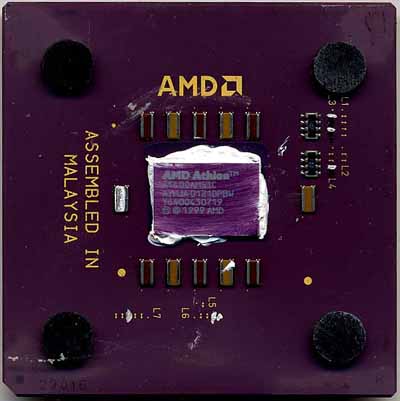Under the KryoCavity is the Socket-462 of the Gigabyte GA-7DX motherboard that Kryotech chose for the SuperG2 system. The Gigabyte GA-7DX is a very solid motherboard that we also use in a few of our web servers; it also carries strong recommendations from AMD. The biggest downsides to the GA-7DX are that it does not have any multiplier adjustments and it only has two DDR SDRAM slots. The latter is a pretty big issue since it limits the amount of memory that can be paired up with the system. With a large portion of the market for a SuperG2 being professionals that require more than 1GB of memory, only two DIMM slots require you to use larger than 512MB modules in order to get greater than 1GB total memory sizes. Unfortunately, 512MB PC2100 DDR modules are hard enough to come by and 1GB modules are still not mainstream enough.
In order to reach 1.866GHz Kryotech uses an Athlon-C running at 1.4GHz (10.5 x 133MHz) with the multiplier modified to be 14.0X. This results in the sub-zero cooling of the CPU allowing for a 33% increase in clock speed, a similar increase to what Kryotech has been able to achieve in the past. Due to time constraints we could not test the system with our Athlon MP 1.2GHz processor to see how far AMD’s Palomino core would overclock.

Since the Thunderbird core has no on-die thermal diode the only way to guage CPU temperature is by using the motherboard's thermistor mounted in the center of the CPU socket. Kryotech applied a bit of thermal grease to the underside of the CPU in order to improve thermal conductivity with the thermister. This should be unnecessary in future Athlon 4 versions of the Kryotech system because the Palomino core includes an on-die thermal diode.
SYS configured our evaluation unit very close to how we'd configure the system. The Gigabyte board was outfitted with a single Crucial 256MB PC2100 DDR SDRAM module (CAS 2). A Leadtek WinFast GeForce3 populated the AGP 4X slot on the AMD 760 based motherboard while a D-Link 100Mbit network card was the only other peripheral card in the system. The Gigabyte's on-board Creative Labs audio was enough for our tastes although SYS offers upgrades to SB Live! cards if you're so inclined.
SYS' hard drive choice was also in line with what we prefer at AnandTech. The default configuration includes a 40GB IBM 60GXP drive; larger versions of the same drive as well as an IDE RAID of two 60GXP drives are available. The biggest disappointment here is limited configuration options from SYS when it comes to SCSI hard drives. At the time of publication the only SCSI offering SYS made available was a IBM 18GB Ultrastar drive. If you're looking for a better I/O subsystem you're probably going to end up going on your own.
The pricing is the weak point when it comes to SYS' preconfigured systems, as the system that was sent to us was easily over $3,000. The main reason for the inflated price being the cost of the Kryotech cooling components themselves. Kryotech also offers barebones systems with nothing more than the case, cooling setup, motherboard and CPU for $2,281 (USD).











0 Comments
View All Comments